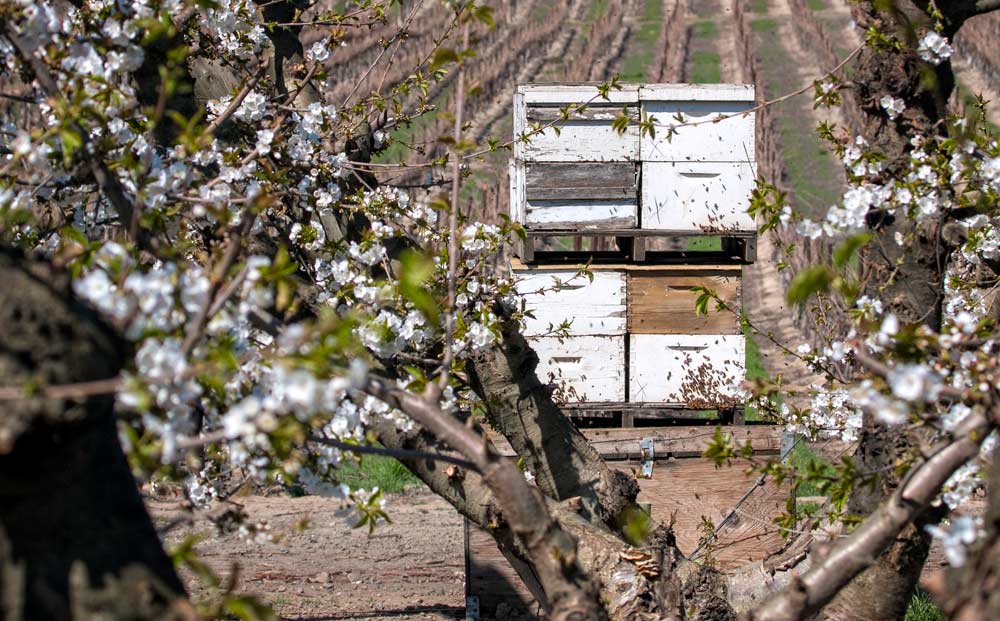
Growers tend to put hives close to orchards to help bees do their work, but if you have to spray for disease control, it’s important to make sure the hives are placed a safe distance away. New research shows fungicide exposure long thought safe can have detrimental effects on bees working in orchards, such as these bees seen in a cherry orchard in bloom in Sunnyside, Washington, in 2015. (TJ Mullinax/Good Fruit Grower)
Making insecticide decisions that best protect pollinators is now commonplace, but growers should also keep bees in mind when it comes to spraying fungicides to manage bloom-time disease.
“How do we minimize harm to bees without compromising pest and disease management? That’s the big question,” said Julianna Wilson, tree fruit outreach specialist for the Michigan State University entomology department. She spoke about protecting pollinators from pesticides at the Great Lakes Fruit, Vegetable, and Farm Market Expo in December.
For a long time, most fungicides were assumed to be safe for bees because toxicology studies show that direct exposure to the compounds don’t kill bees in the lab.
But more recent studies looking at sub-lethal effects found that repeat fungicide exposure can decrease bees’ ability to digest food and weaken their immune systems, Wilson said. Being unable to process food well means lower quality nutrition for larvae and increased stress for the whole colony. That makes them more susceptible to Varroa mites, the Nosema apis parasite and other diseases that can devastate hives.
To protect honeybees from fungicides used during bloom, such as sprays for cherry leaf spot or apple scab, Wilson recommends making sure that hives are placed outside the orchard and upwind from potential drift.
“They will find those fruit blossoms,” Wilson said, even if hives are several hundred yards away. “Bees love visiting stone fruit and pome fruit because it’s high-quality pollen.”
She also recommends calibrating sprayers to minimize drift and turning off sprayers when passing close by hives.
But commercial honeybees are not the only bees to protect. In Michigan orchards, wild bees make up almost half of bee visits to tree fruit flowers. In recent surveys, Wilson found 99 different wild bee species in orchards during bloom, and most are solitary, soil-nesting bees that are really good at moving pollen around. They don’t compete with honeybees but actually appear to make them more efficient, she said.
“Wild bees make the honeybees jump around, otherwise they would just track down a row,” Wilson said. “That’s really good if you need cross pollination like in apples.”
But protecting wild bee populations is more challenging because you can’t just place the hives in a safe location or remove the hives before you begin pest management.
Wilson recommended spraying when bees are less active, such as dusk or after sunset or when temperatures are below 55 degrees, if possible. Growers should also select fungicides that have lower risk to bees if they must spray during bloom.
After bloom, she recommends mowing down blooming weeds on the orchard floor before spraying so they are not attracting bees to your orchard during or right after pesticide application. It’s great to provide pollinators with flowering native plants near your orchard, as pollen diversity has been shown to improve bee health, but it’s important to prevent drift onto those flowers as well, Wilson said.
“The stronger the hives are, the better pollination services they are going to provide,” she said.
More resources on protecting bees from pesticides throughout the season and the risk posed by various chemicals can be found in MSU’s Extension Bulletin E3245 (available online at bit.ly/bee-risk) or on the Integrated Crop Pollination Project website at
www.icpbees.org. •
—by Kate Prengaman






Leave A Comment